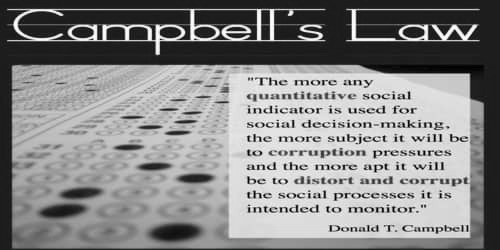Introduction
In the realm of decision-making, cognitive biases often cloud our judgment and lead us astray. One such cognitive trap is Campbell’s Law, a mental model that highlights how the pursuit of quantifiable metrics can distort decision-making processes. Coined by social psychologist Donald T. Campbell, this law suggests that when a measure becomes a target, it ceases to be a valid measure. In simpler terms, when we place excessive emphasis on a single metric, we unwittingly invite unintended consequences and distort the very outcomes we seek to achieve. In this blog post, we will delve into the concept of Campbell’s Law, exploring its relevance in decision-making processes, its psychological underpinnings, and practical strategies to avoid falling into its trap.
The Relevance of Campbell’s Law
At its core, Campbell’s Law highlights the inherent tension between indicators and the true objectives they aim to measure. In an effort to simplify complex systems and gauge success, decision-makers often rely on specific metrics. However, as the focus shifts solely towards achieving higher scores or meeting targets, individuals and organizations may inadvertently manipulate the underlying factors that contribute to the metric. This manipulation undermines the validity of the metric itself and distorts the overall outcome.
Human Psychology and Everyday Prevalence
Campbell’s Law is deeply rooted in human psychology and manifests in various aspects of our lives. Consider the following examples:
Personal Life: Weight Loss and Crash Diets
Imagine an individual who sets a goal of losing a specific amount of weight within a short timeframe. As the target weight becomes the sole focus, the person may resort to extreme crash diets or unhealthy practices to achieve rapid results. However, this narrow focus neglects the importance of sustainable, long-term lifestyle changes, leading to potential health risks and eventual weight gain once the diet ends.
Business Scenario: Sales Quotas and Unethical Behavior
In sales-driven organizations, quotas are often used as a metric to evaluate performance. However, when employees are solely incentivized to meet quotas, they may resort to unethical practices such as aggressive selling, misrepresentation, or even fraud. This behavior arises due to the misalignment between the true purpose of serving customers and the relentless pursuit of meeting numerical targets.
Public Policy: Standardized Testing in Education
Standardized tests are widely used to assess the quality of education and evaluate students’ academic abilities. However, when educational institutions and teachers face significant pressure to achieve high test scores, the focus may shift away from holistic education and towards “teaching to the test.” This narrow emphasis neglects the development of critical thinking, creativity, and other essential skills, ultimately undermining the true purpose of education.
Mental Biases and Psychological Underpinnings
Several mental biases contribute to the prevalence of Campbell’s Law:
Goodhart’s Law: “When a measure becomes a target, it ceases to be a good measure.” This law, closely related to Campbell’s Law, suggests that once a metric is explicitly set as a target, individuals and organizations will adapt their behavior to maximize their performance on that metric, often at the expense of other relevant factors.
Outcome Bias: We tend to judge the quality of a decision based on its outcome rather than the decision-making process itself. When decision-makers face pressure to achieve specific outcomes, they may be more inclined to take shortcuts or manipulate variables to ensure a favorable result, reinforcing Campbell’s Law.
Confirmation Bias: People have a natural inclination to seek and interpret information that confirms their pre-existing beliefs or desired outcomes. When this bias interacts with Campbell’s Law, decision-makers may prioritize information that supports their desired metric, even if it is misleading or incomplete.
Avoiding the Trap of Campbell’s Law
To avoid succumbing to Campbell’s Law, consider the following strategies:
Define Multiple Metrics: Instead of relying on a single metric, establish a comprehensive set of indicators that collectively capture the desired outcome. This approach provides a more holistic view of the situation and reduces the risk of distorting results by fixating on a single measure.
Emphasize Context and Qualitative Insights: Balance quantitative metrics with qualitative insights to gain a deeper understanding of the factors at play. Contextual information can help uncover hidden nuances and identify unintended consequences, preventing myopic decision-making.
Promote Ethical Incentives: Align incentives with the overall purpose and values of the organization or individual. By fostering a culture that values ethical behavior, long-term goals, and holistic success, decision-makers are less likely to fall into the trap of prioritizing metrics at the expense of integrity.
Conclusion
Campbell’s Law serves as a critical reminder of the unintended consequences that arise when metrics become the sole focus of decision-making. By understanding the psychological underpinnings and recognizing the presence of Campbell’s Law in various contexts, individuals and organizations can make more informed decisions. By employing strategies that emphasize a broader perspective, multiple metrics, and ethical considerations, we can avoid distorting outcomes and ensure that our decisions align with our true objectives. Awareness and active avoidance of Campbell’s Law are paramount to achieving meaningful and sustainable success in all areas of life.
References:
Campbell, D. T. (1976). Assessing the impact of planned social change. Evaluation and program planning, 1(1), 67-90.
Goodhart, C. A. (1975). Problems of monetary management: The UK experience. Papers in Monetary Economics, Reserve Bank of Australia, 1-22.
Tetlock, P. E. (2005). Expert political judgment: How good is it? How can we know? Princeton University Press.
